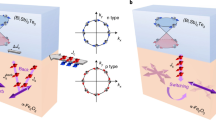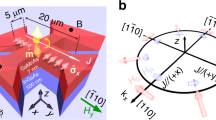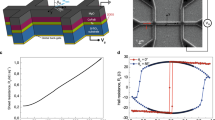Abstract
The electrical switching of magnetization through spin–orbit torque (SOT)1 holds promise for application in information technologies, such as low-power, non-volatile magnetic memory. Materials with strong spin–orbit coupling, such as heavy metals2,3,4 and topological insulators5,6, can convert a charge current into a spin current. The spin current can then execute a transfer torque on the magnetization of a neighbouring magnetic layer, usually a ferromagnetic metal like CoFeB, and reverse its magnetization. Here, we combine a ferromagnetic transition metal oxide7 with an oxide with strong spin–orbit coupling8 to demonstrate all-oxide SOT devices. We show current-induced magnetization switching in SrIrO3/SrRuO3 bilayer structures. By controlling the magnetocrystalline anisotropy of SrRuO3 on (001)- and (110)-oriented SrTiO3 (STO) substrates, we designed two types of SOT switching schemes. For the bilayer on the STO(001) substrate, a magnetic-field-free switching was achieved, which remained undisturbed even when the external magnetic field reached 100 mT. The charge-to-spin conversion efficiency for the bilayer on the STO(110) substrate ranged from 0.58 to 0.86, depending on the directionality of the current flow with respect to the crystalline symmetry. All-oxide SOT structures may help to realize field-free switching through a magnetocrystalline anisotropy design.
This is a preview of subscription content, access via your institution
Access options
Access Nature and 54 other Nature Portfolio journals
Get Nature+, our best-value online-access subscription
$29.99 / 30 days
cancel any time
Subscribe to this journal
Receive 12 print issues and online access
$259.00 per year
only $21.58 per issue
Buy this article
- Purchase on Springer Link
- Instant access to full article PDF
Prices may be subject to local taxes which are calculated during checkout




Similar content being viewed by others
Data availability
The data that support the plots within this paper and other findings of this study are available from the corresponding author upon reasonable request.
References
Manchon, A. et al. Current-induced spin–orbit torques in ferromagnetic and antiferromagnetic systems. Preprint at http://arXiv.org/abs/1801.09636 (2018).
Miron, I. M. et al. Perpendicular switching of a single ferromagnetic layer induced by in-plane current injection. Nature 476, 189–193 (2011).
Liu, L. et al. Spin-torque switching with the giant spin Hall effect of tantalum. Science 336, 555–558 (2012).
Zhu, L., Ralph, D. C. & Buhrman, R. A. Highly efficient spin-current generation by the spin Hall effect in Au1–xPtx. Phys. Rev. Appl. 10, 031001 (2018).
Mellnik, A. R. et al. Spin-transfer torque generated by a topological insulator. Nature 511, 449–451 (2014).
Mahendra, D. C. et al. Room-temperature high spin–orbit torque due to quantum confinement in sputtered BixSe(1–x) films. Nat. Mater. 17, 800–807 (2018).
Koster, G. et al. Structure, physical properties, and applications of SrRuO3 thin films. Rev. Mod. Phys. 84, 253–298 (2012).
Patri, A. S., Hwang, K., Lee, H.-W. & Kim, Y. B. Theory of large intrinsic spin Hall effect in iridate semimetals. Sci. Rep. 8, 8052 (2018).
Sinova, J., Valenzuela, S. O., Wunderlich, J., Back, C. H. & Jungwirth, T. Spin Hall effects. Rev. Mod. Phys. 87, 1213–1260 (2015).
Yu, A. B. & Rashba, E. I. Oscillatory effects and the magnetic susceptibility of carriers in inversion layers. J. Phys. C 17, 6039–6045 (1984).
Guo, G. Y., Murakami, S., Chen, T. W. & Nagaosa, N. Intrinsic spin Hall effect in platinum: first-principles calculations. Phys. Rev. Lett. 100, 096401 (2008).
Yu, G. et al. Switching of perpendicular magnetization by spin–orbit torques in the absence of external magnetic fields. Nat. Nanotechnol. 9, 548–554 (2014).
Fukami, S., Zhang, C., Dutta Gupta, S., Kurenkov, A. & Ohno, H. Magnetization switching by spin–orbit torque in an antiferromagnet–ferromagnet bilayer system. Nat. Mater. 15, 535–541 (2016).
Oh, Y. W. et al. Field-free switching of perpendicular magnetization through spin–orbit torque in antiferromagnet/ferromagnet/oxide structures. Nat. Nanotechnol. 11, 878–884 (2016).
Hwang, H. Y. et al. Emergent phenomena at oxide interfaces. Nat. Mater. 11, 103–113 (2012).
Marshall, A. F. et al. Lorentz transmission electron microscope study of ferromagnetic domain walls in SrRuO3: statics, dynamics, and crystal structure correlation. J. Appl. Phys. 85, 4131–4140 (1999).
Jung, C. U., Yamada, H., Kawasaki, M. & Tokura, Y. Magnetic anisotropy control of SrRuO3 films by tunable epitaxial strain. Appl. Phys. Lett. 84, 2590–2592 (2004).
Schultz, M., Levy, S., Reiner, J. W. & Klein, L. Magnetic and transport properties of epitaxial films of SrRuO3 in the ultrathin limit. Phys. Rev. B 79, 125444 (2009).
Gan, Q., Rao, R. A., Eom, C. B., Wu, L. & Tsui, F. Lattice distortion and uniaxial magnetic anisotropy in single domain epitaxial (110) films of SrRuO3. J. Appl. Phys. 85, 5297–5299 (1999).
Liao, Z. et al. Controlled lateral anisotropy in correlated manganite heterostructures by interface-engineered oxygen octahedral coupling. Nat. Mater. 15, 425–431 (2016).
Lu, W. et al. Strain engineering of octahedral rotations and physical properties of SrRuO3 films. Sci. Rep. 5, 10245 (2015).
Lu, W., Yang, P., Song, W. D., Chow, G. M. & Chen, J. S. Control of oxygen octahedral rotations and physical properties in SrRuO3 films. Phys. Rev. B 88, 214115 (2013).
Gong, Y. et al. Band gap engineering and layer-by-layer mapping of selenium-doped molybdenum disulfide. Nano Lett. 14, 442–449 (2014).
Qin, Q., Song, W., He, S., Yang, P. & Chen, J. Magnetization reversal and magnetoresistance behavior of exchange coupled SrRuO3 bilayer. J. Phys. D Appl. Phys. 50, 215002 (2017).
Eason, K., Tan, S. G., Jalil, M. B. A. & Khoo, J. Y. Bistable perpendicular switching with in-plane spin polarization and without external fields. Phys. Lett. A 377, 2403–2407 (2013).
You, L. et al. Switching of perpendicularly polarized nanomagnets with spin–orbit torque without an external magnetic field by engineering a tilted anisotropy. Proc. Natl Acad. Sci. USA 112, 10310 (2015).
Liu, L., Lee, O. J., Gudmundsen, T. J., Ralph, D. C. & Buhrman, R. A. Current-induced switching of perpendicularly magnetized magnetic layers using spin torque from the spin Hall effect. Phys. Rev. Lett. 109, 096602 (2012).
Zhao, Z., Klemm Smith, A., Jamali, M. & Wang, J.-P. External-field-free spin Hall switching of perpendicular magnetic nanopillar with a dipole-coupled composite structure. Preprint at http://arXiv.org/abs/1603.09624 (2016).
Wang, X.et al. Current-driven magnetization switching in a van der Waals ferromagnet Fe3GeTe2. Preprint at http://arXiv.org/abs/eprintarXiv1902.05794 (2019).
Yoshimi, R. et al. Current-driven magnetization switching in ferromagnetic bulk Rashba semiconductor (Ge,Mn)Te. Sci. Adv. 4, eaat9989 (2018).
Hayashi, M., Kim, J., Yamanouchi, M. & Ohno, H. Quantitative characterization of the spin–orbit torque using harmonic Hall voltage measurements. Phys. Rev. B 89, 144425 (2014).
Garello, K. et al. Symmetry and magnitude of spin–orbit torques in ferromagnetic heterostructures. Nat. Nanotechnol. 8, 587–593 (2013).
Acknowledgements
The research is supported by the Singapore National Research Foundation under CRP Award no. NRF-CRP10-2012-02 and the Singapore Ministry of Education MOE2018-T2-2-043 and MOE 2018-T2-1-019, AMEIRG18-0022 and A*STAR IAF-ICP 11801E0036. J.C. is a member of the Singapore Spintronics Consortium (SG-SPIN). C.L. acknowledges the financial support from the Lee Kuan Yew Postdoctoral Fellowship through the Singapore Ministry of Education Academic Research Fund Tier 1 (Grant no. R-284-000-158-114).
Author information
Authors and Affiliations
Contributions
L.L. and J.C. conceived and designed the experiments. L.L., W.Lin, Q.Q., Q.X., X.S., C.Z. and J.Y. performed the sample fabrication and experimental measurements. L.L, W.Lin, Q.Q., S.H., Z.L., W.Lu and X.Y. analysed the electrical transport data. C.L., M.L. and S.J.P. performed the STEM. L.L., W.Lin, Q.Q. and J.C. wrote the manuscript and all authors contributed to its final version.
Corresponding author
Ethics declarations
Competing interests
The authors declare no competing interests.
Additional information
Peer review information: Nature Nanotechnology thanks Lior Klein and the other, anonymous, reviewer(s) for their contribution to the peer review of this work.
Publisher’s note: Springer Nature remains neutral with regard to jurisdictional claims in published maps and institutional affiliations.
Supplementary information
Supplementary Information
Supplementary Figs. 1–16, Table 1 and Refs. 1–22.
Rights and permissions
About this article
Cite this article
Liu, L., Qin, Q., Lin, W. et al. Current-induced magnetization switching in all-oxide heterostructures. Nat. Nanotechnol. 14, 939–944 (2019). https://doi.org/10.1038/s41565-019-0534-7
Received:
Accepted:
Published:
Issue Date:
DOI: https://doi.org/10.1038/s41565-019-0534-7
This article is cited by
-
The central role of tilted anisotropy for field-free spin–orbit torque switching of perpendicular magnetization
NPG Asia Materials (2024)
-
Highly efficient field-free switching of perpendicular yttrium iron garnet with collinear spin current
Nature Communications (2024)
-
Field-free spin-orbit switching of perpendicular magnetization enabled by dislocation-induced in-plane symmetry breaking
Nature Communications (2023)
-
Large spin–orbit torque in bismuthate-based heterostructures
Nature Electronics (2023)
-
Anomalous spin current anisotropy in a noncollinear antiferromagnet
Nature Communications (2023)



